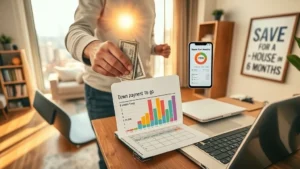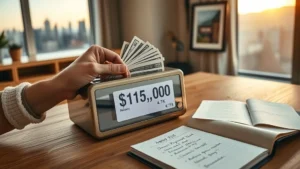Hold On—Is This Really Possible?
Most people don’t realize you can own a home—yeah, your actual place, mail in your own little slot and all—with a low income and no massive pile of cash stashed under your mattress. If you’ve scrolled through Zillow or Realtor.ca while heating up ramen, you’ve probably laughed and thought, “Not in this lifetime.” But hang on. The whole story isn’t just about down payments and big salaries. There are cracks in those so-called “impossible” walls, and with the right know-how, you just might squeeze through.
I used to think buying a house was only for people with perfectly ironed shirts, gold-plated Tupperware, and a suspicious love for spreadsheets. Turns out, it’s a lot messier… and you don’t have to be rich or perfect to get in. Let’s walk through the real ways people like you (and me!) have made it happen—even if money’s tight and “down payment” sounds like a cruel joke.
No Down—Now What?
So, Do You NEED 20% Stashed?
This gets thrown around a lot—the dreaded 20%. Here’s the truth: In Canada, the minimum down payment is 5% for homes up to $500,000. If you’re shopping somewhere pricier? It’s 5% on the first $500,000 and 10% on the rest. For houses at a million and up, yes, you’ll need 20%, but for most regular folks, that’s not the price range anyway. And if you put down less than 20%, you’ll just need something called mortgage insurance (CMHC rules explained here). It’s not the end of the world—just another line on your statement. Don’t get scared off by jargon.
“No Down” Isn’t “No Money Ever.” What’s the Catch?
This is where the story gets interesting. Technically, you’ll always need to cover some costs up front—think legal fees, taxes, maybe a home inspection. But as wild as it sounds, you really can buy a house without saving up the down payment yourself. Instead, the money might come from other (totally legal) sources: a government program, a family gift, even a loan or line of credit borrowed specifically to be used as your down payment… if you know where to look. No, the bank is not just handing out keys for free, but there’s room to maneuver if you’re creative (see detailed steps).
Table: Comparing Down Payment Paths
| Option | Down Payment Source | Typical Requirements | Pros | Cons |
|---|---|---|---|---|
| Traditional | Your savings | 5–20% down, good credit | Lowest rates, more equity | Slow to save, tough on low income |
| Gift Funds | Family/relative gift | Need gift letter | No repayment needed | Requires generous family |
| Government Programs | Loan, grant, or shared equity | Meet income limits, first-time buyer | Lower upfront cost | Paperwork, may repay later |
| Borrowed Down | Personal loan/credit line | Decent credit, proof of income | Quick access | Higher monthly payments |
Let’s Talk About Programs
Federal & Provincial Lifelines
Ever heard of Canada’s First-Time Home Buyer Incentive? It’s basically the government chipping in 5% or 10% of your purchase price as shared equity—meaning you get help up front, and pay back their cut when you sell. Not bad. In Quebec, Montreal’s Accès Condos and Quebec City’s Accès Famille programs literally lend you the down payment as a no-interest chunk. Ontario’s got a bunch of city-based options, too, like the Welcome Home Niagara program (10% interest-free, up to $66Kish for folks earning less than $95K solo, $113K for families).
Most of these are tailored for folks who aren’t rolling in disposable income. The catch is you might need to prove you’re a legit resident, have a decent credit score, be a first-timer, and snag a mortgage pre-approval.
Eligibility Checklist
- Low to moderate income (usually under $95-120K household, check your city’s rules)
- First-time buyer (sometimes means “can’t own or have owned property” in Canada or anywhere else before)
- Clean legal standing, no property “interests” elsewhere
- Must live in the house (no renting it out, usually)
- Mortgage pre-approval from a recognized lender
Have you ever checked what your city or province offers? Sometimes programs open and close every year. Get on those waitlists early. (And yes, your cousin’s friend actually got approved—it’s not a myth!)
Family to the Rescue?
If you have generous family or friends, a “gift” down payment is not only possible—it’s completely acceptable. The banks just need a signed letter stating this isn’t a loan (otherwise your debt-to-income ratio takes a hit). Don’t have family with piled-up cash? Don’t stress. Even a small top-up helps you qualify for better rates or programs.
Saving, Frugality, and Real-Life Budgets
Can You Really Scrape It All Together?
This is where the frugal hacker in me gets excited. You don’t always have to go from zero to “ready to buy” in one leap. Sometimes, the best move is chunking your savings goals—aiming for short, doable sprints like How to save money for a house fast. What does that even mean? Think… spending freezes (no, not forever), automating $10 here and there, selling that old bike on Marketplace. Not glamorous, but it adds up.
My friend Tasha capped her breakfast spending to $1/day and canceled two subscriptions—she saved nearly $180/month without missing much joy. In less than a year, she had enough for closing costs… and her Netflix-free evenings fueled her book habit instead (win-win).
Speed Run or Slow Burn?
If you like a challenge, you could push for a 2-year plan (How to save for a house in 2 years), tossing every spare dollar—and yes, every side-hustle gig—toward your future home. It’s not easy. But if 2 years is too fast, there’s no shame in setting a bigger horizon. See what a 5-year crusade looks like with How to save for a house in 5 years. The key? Consistency beats intensity. Even saving $20/week gets you over $1,000/year—and that’s before you hunt down any “found” money, like tax returns or rebates.
Compare: Fast vs. Slow Save Plans
| Approach | Monthly Save Goal | Years to $12,000 | Energy Required? |
|---|---|---|---|
| Fast (2 Years) | $500 | 2 | High; side hustles/ad hoc |
| Slow (5 Years) | $200 | 5 | Moderate; long game |
Real Talk: Credit, Debt, and Approval Odds
Bumping the Odds in Your Favour
Banks want to see you’re not drowning in debt. So, if your debt-to-income ratio (your monthly debt divided by your gross income) is under 43%, you’re golden. Even if you make $38K a year, steady employment matters—a long work history often counts more than a giant salary.
Crummy credit? Don’t give up; start fixing it today. Pay utilities on time. Avoid payday loans (banks frown on these). And no, you don’t need to buy credit repair services. Slow, steady improvement works.
And then… alternative lenders. Some credit unions, or even online lenders, let you use a line of credit or even a personal loan for some or all of your down payment (see details on this approach). Just make sure to compare interest rates—borrowing at 19% is not the same as borrowing at 4%.
On a Low Income? You’re Not Alone.
I can’t count how many friends worry that low-income means “no dice” for home buying. The truth? There’s no minimum income requirement across Canada to buy a home—banks and insurers care about your ability to repay, not a magic dollar amount. In practice, this means your income, debts, credit, and property price all matter together. Some cities use “area median income”—sometimes 80% of that is still enough for first-time programs.
So, if you’re pulling in $40K, single, maybe with a kid, don’t panic. There are buyers with tighter budgets who’ve made it with the right tools and guidance. The journey might take longer—but every step forward is one you can be proud of. And try How to save money fast on a low income for some extra ideas that actually work on a budget.
Your Next Steps—Let’s Make This Real
Okay, deep breath. By now, you know that how to buy a house with low income and no down payment isn’t a fairy tale, but it’s not a walk in the park either. Programs like CMHC-insured mortgages, shared equity options, city grants, or even family gifts can turn a “no way” into a “heck yes.” Combining frugal living, creative savings, and the courage to apply (even if you think you might not qualify) goes further than you think.
Here’s what I’d do next if I were starting again: check your local programs. (Seriously, Google your city + “down payment assistance.”) Get pre-approved, just to see where you stand—even imperfect credit might be enough. Pick one easy budget tweak today: skip fancy coffee, quit a subscription, round up your spare change. See if you can direct those micro-savings to a separate “new home” account. It feels small, but wow, it adds up fast.
Most importantly? Don’t let fear of a low income or small savings pot keep you out. I’ve seen solo parents, new immigrants, gig workers—real people—turn the key in their own front doors. Why not you, too?
Your story isn’t decided by your bank balance. It’s shaped by what you do next. Ready to start? Grab your coffee and poke through your city’s options. Or try one of the savings plans linked above, and see where small changes can lead. Homeownership isn’t just a far-off wish—it might be closer than you think. You deserve a place with your name on the mailbox. Go get it.










